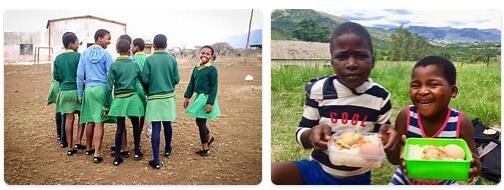Yearbook 2016
Swaziland. The current population of Eswatini is 1,160,175. The country was plagued by the severe drought in a region that received less rainfall than 35 years ago. The sowing was delayed for two months, the maize harvest became poor and food prices were pushed up. Lack of water and grazing killed many livestock. The government proclaimed national Christianity in February, a few weeks after King Mswati claimed that God saved Swaziland from the drought.

A quarter of the population needed help, and the capital, Mbabane, introduced water rationing for the first time in its history. Irrigation was also limited, which affected, among other things, the harvest of sugar cane, which accounts for just over one-fifth of the country’s GDP.
In a June speech, King Mswati described Swaziland’s governance as a new democratic ideology. According to the king, democracy means that the subjects choose those who give advice to the king. The power lies with the royal house, which stands over both legislators and government.
In a court ruling in September, parts of the country’s anti-terror law were declared to be in violation of the constitution’s guarantee of freedom of conscience, opinion and meeting. The Anti-Terrorism Act has been used by the government to ban political groups that oppose King Mswati’s rule, including the opposition party PUDEMO.
It was lawyer Thulani Maseko, who spent 16 months in prison for criticism of the government, who challenged the law in court along with PUDEMO leader Mario Masuku. The latter is charged with what the prosecutor calls terrorism and insurgency.
The ruling meant that regime critics should have the opportunity to express their views without the fear of reprisals. The verdict showed the judiciary’s independence from the government and reaffirmed the supremacy of the constitution. The government appealed the ruling to the Supreme Court.
During the year Swaziland took over as chair of the South African regional cooperation body SADC. Swaziland’s solidarity network SSN believed that Swaziland’s presidency made the region look like a stronghold for dictators.
According to thereligionfaqs, game keepers in Swaziland asked during the year at the UN to sell the country’s stock of rhino horns to finance efforts against poaching and maintenance of wildlife reserves. It involved hundreds of kilos of horns from animals that died naturally or horns seized from poachers. According to wildlife officials, regulated trade could reduce poaching by meeting demand – especially in Asia for traditional medicine – legally. However, Swaziland’s request was voted down at an international conference on the Convention on International Trade in Endangered Species.
History. – The claim of this territory – the smallest of the British protectorates of South Africa, located on its northeastern border and partly in contact with Portuguese Mozambique – was continued, by the South African government, with the British government. But London, while not denying in principle the transfer commitment assumed at the time of the establishment of the South African Union, continued to resist the pressures of Pretoria, especially by appealing to the desire of the people of Swaziland. The requests of the South African Union did not arrive, until the Second World War, but with the creation, in 1938, of a Joint Advisory Conference Anglo-South African, which in practice did not achieve any results. Britain’s aversion to relocation deepened after the government of the South African Union was taken over by the nationalists in 1948, as the indigenous population expressed a clear reluctance to relocate under racially discriminatory authority. The Malan government’s insistence for a quick solution, accompanied by the threat, in the event of non-acceptance of the requests, of an economic boycott of Swaziland was of no avail. At the new insistence of the South African governments chaired by JG Strijdom and HF Verwoerd, the British government seemed indeed to move towards the granting of greater internal autonomy within the protectorate territory, apartheid pursued by the South African Union.